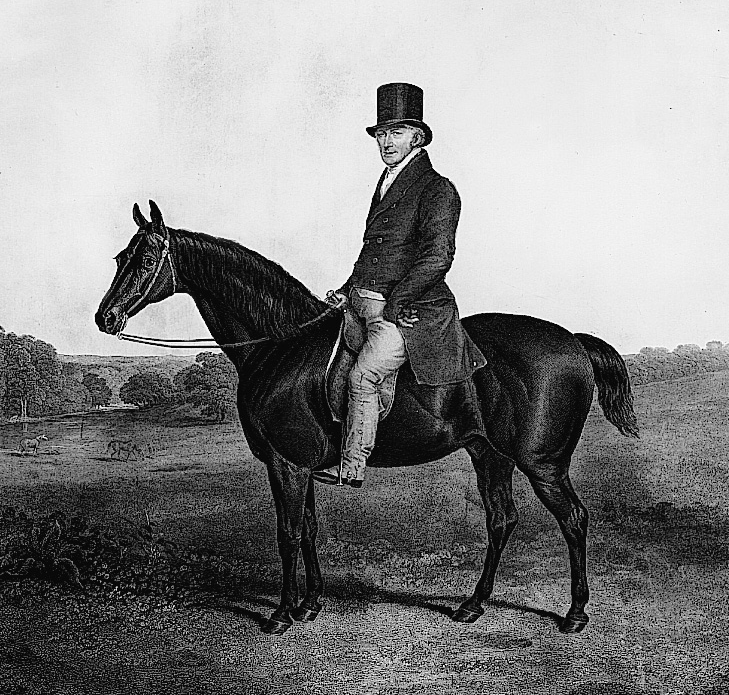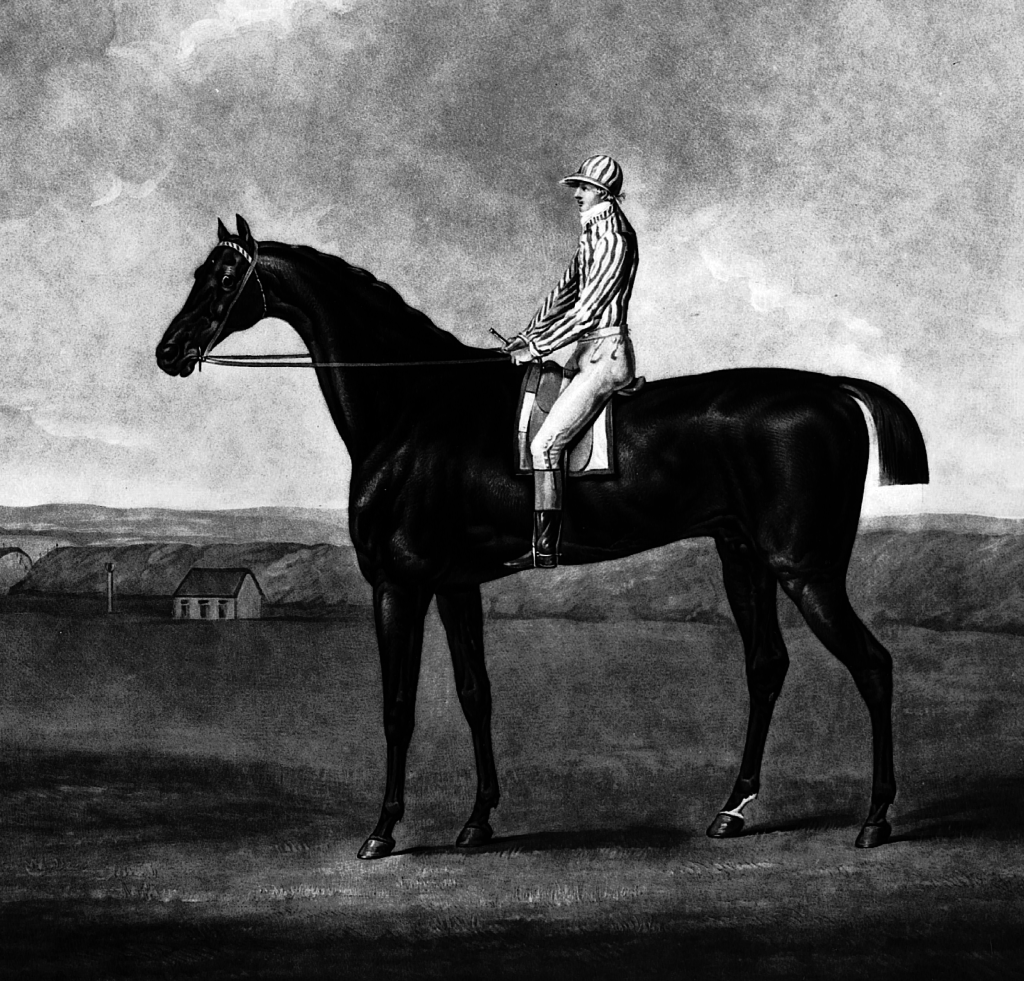The Origins of the 1,000 & 2,000 Guineas
Both races being named after the original prize fund
2000 Guineas
First run 18th April 1809
Course: Rowley Mile 1 mile 1 yard.
Weights: Colts and geldings 8st 3lb, fillies 8st 0lb
Latest date run 25 May 1943 Summer Course (WWII)
1809 result:
1st Wizard 4-5 fav: 2nd Robin, 3rd Fair Star. 8 ran.
Prize £1,522
Owner Christopher Wilson
Trainer not listed
Jockey William Clift
1000 Guineas
First run 28 April 1814
Course: Ditch Mile, Newmarket: 7f. 178 yds
Run over Ditch Mile to 1872, then Rowley Mile.
Weights: Fillies 8st 4lb (same as for 1814 2000 Guineas)
Latest date run 26 May 1943 Summer Course (WWII)
1814 result:
1st Charlotte 11-5 fav; 2nd Vestal 3rd Medora. 5 ran.
Prize £682
Owner Christopher Wilson
Trainer not listed
Jockey William Clift
Early Players in the 1,000 & 2,000 Guineas
(View mobiles landscape)
William Clift (1762-1840), had the honour of riding the inaugural winners of both the 2000 Guineas (Wizard) and the 1000 Guineas (Charlotte), within a haul of 13 Classic winners that included five winners of the Derby. A man of humble beginnings, he was born on the estate of the Marquess of Rockingham at Wentworth Park, near Swinton in Yorkshire. There, starting life as a shepherd boy he was asked to ride in the pony races at one of Rockingham’s house parties. Clift rode and won with such determination that the Marquess sent him to his local trainer, Christopher Scaife, who soon after, relocated to Newmarket, accompanied by Clift.
A rough diamond in speech and in his style of riding, his absolute honesty brought him widespread patronage. He later trained for Earl Fitzwilliam, with assistance of his son Thomas. On retiring from racing, he received three pensions from his employers; Christopher Wilson, the Duke of Portland and Lord Fitzwilliam. A fit and wiry little man into his late 70’s, he would often walk the 28 miles from Newmarket to Bury St Edmunds and back as regular exercise.
Christopher Wilson (1764-1842), of Oxton Hall, Tadcaster, owned the inaugural winners of both the 2000 and 1000 Guineas. In addition he was the first owner to win the Derby and St Leger with the same horse – Champion in 1800 – a double not repeated until Surplice won both races for Lord Clifden in 1848. The son of a bishop, he was frequently employed to settle disputes on the Turf and in 60 years of racing he rarely missed a meeting at Ascot, Doncaster, Epsom, Newmarket and York. He died at Christie’s, St James’s Street, on Derby Day 1842.

Christopher Wilson
Robert Robson (1765-1838), was noticeably less hard on his horses than other trainers. He commenced his career as a private trainer to Sir Ferdinand Poole at Lewis in 1793. And later, when known as “The Emperor of Trainers,” he sent out 34 Classic winners, including six winners of the 2000 Guineas and nine winners of the 1000 Guineas, many of which never raced as a juvenile. However, when Robson trained from Newmarket before the use of the mobile horse-box, he had no St Leger winners, whereas John Scott, who trained at Malton a few years later and rented a gallop at Doncaster, notched up a record 16 winners of the Doncaster Classic. On Robson’s retirement in 1828, he was presented with a valuable piece of plate “in recognition of his skill and worthiness”, subscribed to by many notable patrons of the Turf.
Sir Thomas Charles Bunbury (1740-1821), was the son of a vicar at Great Barton, near Newmarket. He was elected a Whig MP for Mildenhall, Suffolk, at the age of 21 and became a strong opponent of the slave trade. He was the first outstanding member of the Jockey Club and became a senior Steward at the age of 28, thereafter taking the role of ‘perpetual president’.
However, like the Earl of Derby, he too was subject to a scandal. After his marriage to the notorious Lady Sarah Lennox in 1762, she had an affair with Lord William Gordon, giving birth to his daughter. The couple eloped taking the child with them, but when Lord William abandoned her, Sir Charles refused to take her back and thereafter, gave more time to Parliament and the Turf.
Although losing the legendary coin toss to name the Derby, Sir Charles had the pleasure of owning the first Derby winner – Diomed. He also owned Eleanor (1801), the first filly to win both the Derby and the Oaks, and Smolensko (1813), a fine looking black horse by Sorcerer, the first horse to win both the Two Thousand Guineas and the Derby. Famously, he also bred Highflyer (b.c. 1774), by Herod ex Rachel by Blank, who was never beaten on the racecourse and the Champion Sire 13 times.. Without doubt, on the Turf, Sir Charles was the most influential man of his age.

1813 Smolensko with Tom Goodisson up
The Classics Overview
If our five Classic races started off as little acorns, they have undoubtedly grown into solid oaks. Neither their conception, nor their first few running’s, can have been considered to have been part of an overall plan. However by the end of the 18th century, the Derby, Oaks and St Leger were being referred to as the “Three Great Races”. This was to continue until the mid-19th century when the two Guineas races were fast becoming thought of as something more than just trials for the Derby and Oaks.
The Triple-Crown wins of West Australian in 1853 and Gladiateur in 1865, did much to cement the pattern of the then known Classic races. The idea of the set of five events for three-year-olds, run over a graduation of distance throughout the year, seemed a natural order and once they were established as a set of Classic races, the idea proved popular and was accepted by almost all other racing countries.